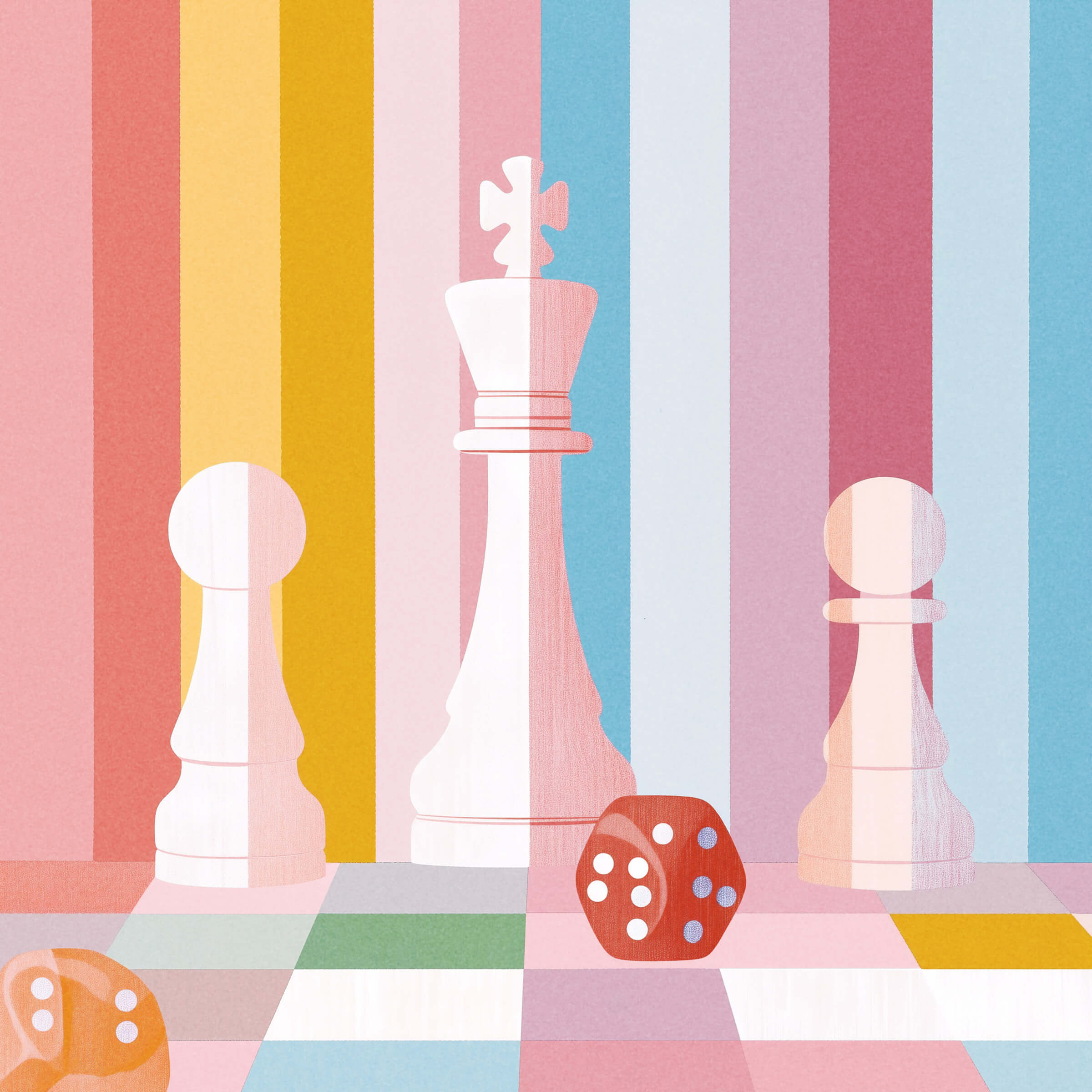
From Tombs to Tabletop: A Brief History of Board Games in 37 Fun Facts
Board games have been around longer than algebra, forks, and your ancestors' last original thought. For thousands of years, humans have been sitting around arguing over who gets to move what, roll what, or hoard fake currency the fastest. And while the rules have changed, one thing hasn’t: people love turning boredom into structured conflict.
This post isn’t just a timeline...it’s a highlight reel of the best, weirdest, and most telling board game facts from history. You’ll meet pharaohs who packed their game boards for the afterlife, Romans who blurred the line between gaming and gambling, and 20th-century families who weaponized Monopoly during economic collapse. We even get into modern classics like D&D, Magic, and that Pokémon RPG your cousin still insists is “totally different” from the video game.
And yes, we know a thing or two about games ourselves...we make trivia decks for a living. So consider this your free sample: no dice, no setup, no rules lawyers; just fun facts, sorted by century.
Jump to:
Ancient & Classical Games
Medieval & Early Modern Games
20th Century Classics
Modern Board Game Culture
Pop Culture & Trivia Games
Ancient & Classical Games (Before 500 CE)
1. The oldest known board game was buried with Egyptian pharaohs.
Senet dates back over 5,000 years and shows up in the ancient tombs of Egyptian royalty, including King Tut. If you thought Monopoly games took too long to end, imagine packing one in your coffin. Historians think Senet symbolized a soul’s journey through the afterlife, which makes losing even more awkward.

2. The Royal Game of Ur may have outlived empires.
Dating back to 2600 BCE in Mesopotamia, Ur somehow stuck around until the 1950s—played in India’s Jewish communities. That’s a 4,500-year shelf life. It’s basically the Keith Richards of board games.
3. Ancient Egyptians also played a board game shaped like a snake.
Mehen was a spiral game with lion-shaped pieces that slithered around a board resembling a coiled serpent. The rules are long gone, but based on the art, it looked intense. Either a game or a very specific way to summon something unpleasant.
4. Ancient Cretans made a board game using ivory, rock crystal, and glass paste.
The game, known only as the Knossos Game or Zatrikion, was found in the Palace of Knossos and dates to 1600 BCE. Only one board exists. It looks like it belonged to someone who died before finishing the rulebook.
5. One ancient Egyptian game board had two different games on it.
Some Senet boards had The Game of Twenty Squares on the back... a variant of the Royal Game of Ur. It's either a space-saving design or the earliest example of someone flipping a board in frustration and just starting a new game.

6. Mancala has been played in Africa for thousands of years, using holes and seeds.
Warri, one of the many Mancala variants, was found carved into stone across ancient African sites. It's less about luck and more about counting; and trash-talking in multiple Bantu languages.
7. Greek art shows heroes playing a game called Pessi during the Trojan War.
We don’t know the rules, but apparently Achilles and Ajax played it between battles. Either it was incredibly intense, or Homer just needed a break from writing fight scenes.
8. Romans played a backgammon knockoff called Tabula.
Tabula featured dice and 24 spaces. Sound familiar? (ask your grandma) It was popular in both the Roman and Byzantine Empires and served as the bootleg version of modern backgammon. Proof that even 1,500 years ago, people were arguing over the doubling cube.
9. The Romans also played a capture game called Latrunculi, which no one fully understands.
Latrunculi was a grid-based game where players surrounded each other’s pieces to capture them. It was sort of like chess meets checkers, minus the clear instructions. Historians still can’t agree on the rules, but that hasn’t stopped people from trying. Classic Rome: dramatic and confusing.
10. The Vikings played chess, but way more metal.
Hnefatafl, also called “Viking chess”, involved a lopsided battle where one player controlled a king trying to escape while the other swarmed with attackers. It was widespread in early medieval Scandinavia, which tells you a lot about Norse leisure time.

Medieval & Early Modern Games (500–1850 CE)
11. Chess was invented in India to simulate war, not bore family members.
Chess began around the 6th century during the Gupta Empire as Chaturanga, with pieces representing four military units. When it hit Europe in the 15th century, the queen gained absurd powers and the bishop learned diagonal movement. Because apparently nothing says realism like letting royalty teleport across the board.
12. The first official chess tournament happened in 1851... and it kind of flopped.
Held in London, the 1851 tournament was a marketing move for chess and also an excuse to get smart men in waistcoats to sit quietly for hours. The winner, Adolf Anderssen, didn’t even win any money. Just everlasting fame and the honor of people mispronouncing his name forever.
13. Nine Men’s Morris was the viral hit of medieval Europe.
This game, where players make “mills” (rows of three) to remove opponents’ pieces, dates back to at least 1400 BCE but really blew up in medieval times. People scratched boards onto cathedral seats, castle stones, and their dignity. It’s checkers’ moodier cousin, and yes, it’s still playable.

14. Checkers is older than you think and had a name change to dodge sounding like a militia.
Checkers, also known as draughts, can be traced back to a game called Alquerque played in ancient Egypt. Modern checkers rules were only standardized in the 16th century. So it took humanity about 3,000 years to agree on “king me”.
15. The Romans played board games to avoid gambling crackdowns.
During stretches of moral panic, gambling was banned... but board games weren’t. So the line between the two got blurry fast. Basically, if you squint hard enough, dice games suddenly become “cultural enrichment”.
20th Century Classics (1900–1995)
16. Monopoly was originally an anti-capitalist protest game.
Elizabeth Magie created The Landlord’s Game in 1903 to warn people about the dangers of monopolies. It was not meant to be fun. It was meant to teach you why landlords suck. Parker Brothers eventually bought it, scrubbed out the message, and turned it into the least fun way to ruin friendships.

17. Scrabble was rejected by every toy company that saw it.
Alfred Butts invented Scrabble in the 1930s, combining anagramming with math. Nobody wanted it. Eventually, a game-loving entrepreneur played it on vacation and started making it in his basement. Now it's sold in 121 countries and still ruins otherwise peaceful holidays.
18. Clue was invented in a bomb shelter.
The original Cluedo was designed by a British factory worker named Anthony Pratt during World War II to pass the time in air raid shelters. Nothing says escapism like pretending to be murdered in a library while real bombs fall outside.
19. The Great Depression turned Monopoly into a household name.
People couldn’t afford vacations or luxuries, but they could afford to yell at their spouse for charging $550 in fake rent. Parker Brothers bought the rights in the '30s and helped turn Monopoly into the all-American tradition of pretending to be rich while being very much not.
20. Mousetrap and Hungry Hungry Hippos happened because of postwar baby boredom.
In the mid-20th century, toy companies pivoted to creating pure chaos for children. Mousetrap was a Rube Goldberg machine with no real strategy. Hungry Hungry Hippos was four plastic animals in a feeding frenzy. Either way, kids were occupied and parents got a break. Briefly.
21. Settlers of Catan launched the board game renaissance in 1995.
Before Catan, most people thought “board game night” meant Monopoly or death. Klaus Teuber’s sheep-trading, road-building empire changed that. Catan became a global hit, luring adults back to the table and kicking off a wave of Eurogames that didn’t require dice or therapy afterward.

Modern Board Game Culture (1996–Present)
22. Dungeons & Dragons has been played continuously for over 43 years by the same guy.
Robert Wardhaugh started his D&D campaign in 1982 and never stopped. It now has hundreds of characters, multiple timelines, and presumably its own GDP. If commitment had a face, it’d be painting miniatures in a Canadian basement.

23. The largest D&D game ever had 1,227 players in one session.
It was held in 2023 and broke a Guinness World Record. Managing initiative order probably took longer than the actual battle. Also, imagine being player #1,226 and realizing you forgot your dice.
24. D&D is banned in some US prisons, so inmates make dice out of toothpaste.
Corrections officials think it promotes gang activity. Prisoners think it promotes character development. So they improvise dice using soap, toothpaste, or folded paper. Inmates literally have to roll for charisma using hygiene products.
25. The Stranger Things monster Vecna is straight out of D&D.
So is the Mind Flayer. The show didn’t invent those terrifying names, they’re pulled from classic D&D lore. Vecna was a disembodied hand and eye before he was TV’s favorite whispery corpse wizard. Netflix owes a lot to nerds with graph paper.
26. A Monopoly set made of gold and gemstones is worth $2 million.
It was crafted by jeweler Sidney Mobell and includes 23-karat gold houses, diamond-studded dice, and an unavoidable feeling of moral nausea. It’s proof that even capitalism’s satire isn’t safe from luxury branding.
27. Strategy games dominate the board game industry by a landslide.
As of 2022, strategy games made up 69% of all global board game sales. Which is weird, considering 69% of people still think “strategy” means “play nice until I suddenly win”.
28. Chess is still the best-selling board game in the U.S.
More than 3 million chess sets sell every year in the United States. For a game with zero updates in 500 years, that’s impressive. Maybe because it’s the only one where flipping the board is considered a valid closing move.
29. The board game industry was worth $11.88 billion in 2022.
It’s projected to hit $20 billion by 2030. All because people enjoy sitting around a table and accusing each other of sabotage for three hours straight. Capitalism may be broken, but cardboard is booming.
30. About 18% of all Kickstarter projects are for board games.
The average board game Kickstarter raises over $21,000. So if you’re broke, just invent something with hex tiles and a pun in the title. Bonus points if the art has tiny barrels.
31. There are over 150,000 board games in existence today.
Which means even if you played one a day, you’d die before finishing. On the bright side, at least you’d never have to play Monopoly twice.
Pop Culture & Trivia Games
32. Magic: The Gathering’s most iconic bird only exists because an artist drew the wrong thing.
The card Birds of Paradise wasn’t planned. The artwork was originally meant for Tropical Island, but the bird was too prominent, so they gave it its own card. A rare case of artistic overcommitment paying off in mana acceleration.

33. The original Magic deck size was 40 cards (Until tournaments broke everything).
When Magic: The Gathering first launched in 1993, 40-card decks were standard. Then players started gaming the system, and official rules moved to 60 cards with a four-card limit per type. Which is the closest Magic ever got to minimalism.
34. You could pull a basic land as your rare in early Magic booster packs.
Thanks to printing quirks in the Alpha and Beta sets, it was totally possible to open a booster pack and find your rare slot filled with... a swamp. If you cried, Richard Garfield wasn’t sorry.
35. A Magic card was illustrated by the creator’s aunt.
Richard Garfield’s aunt, Rebecca, illustrated the card Stasis—adding a wholesome family touch to a game that regularly destroys friendships.
36. Pokémon tabletop games let you do more than just battle.
There are Pokémon RPGs where you can roleplay as breeders, researchers, or coordinators (not just trainers). They include puzzles, exploration, and just enough stats to remind you it's not all about Pikachu’s special attack. Surprisingly strategic. And yes, very nerdy.

37. In trivia games, knowing weird stuff is a legitimate strategy.
Unlike most games where you plan, build, or bluff, trivia games reward one skill: knowing things you probably shouldn't. From Trivial Pursuit to Jeopardy! to modern decks like ours (hi, we’re Fun Fact Co.), trivia is the only genre where remembering which U.S. president had a pet alligator gives you a competitive edge.
Closing the box
People have been inventing rules, rolling dice, and pretending to be wizards for thousands of years... and somehow, it never gets old. Whether it's ancient Egypt or your cousin’s living room last weekend, games have always been a mirror for how weird, strategic, and occasionally petty humans can be.
If you liked this post, you might also like our other fact-packed distractions: Fun Facts About Studio Ghibli (for animation nerds) or Fun Games to Play in the Car with Tired Kids (for anyone trapped in a vehicle with gremlins).
Or check out the trivia games we make. They're weird, smart, and actually fun (which is more than we can say for Monopoly:-).






